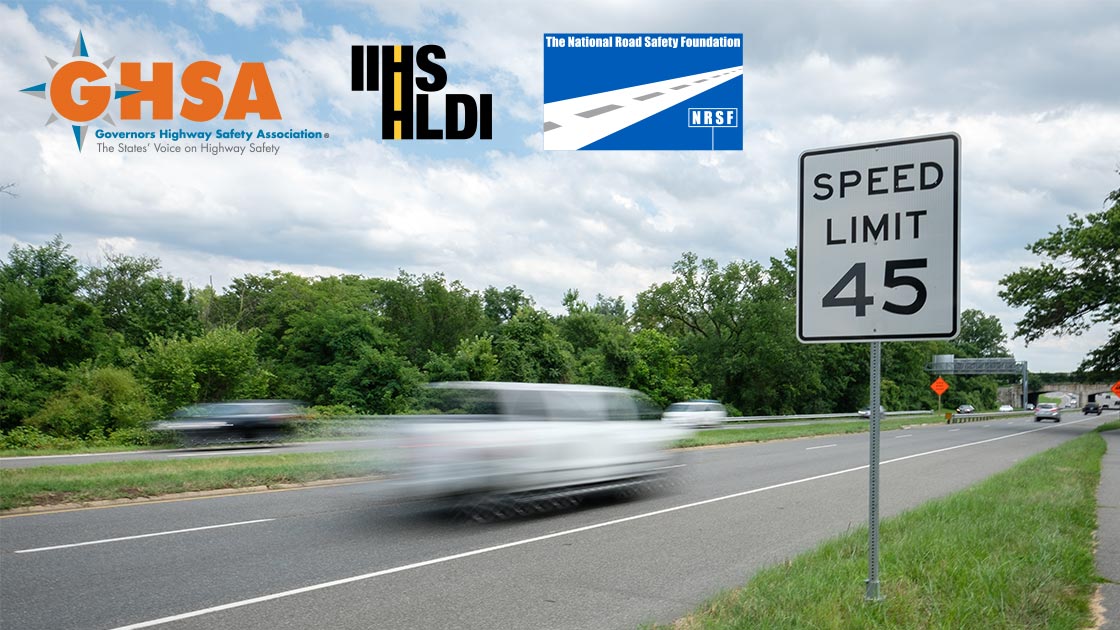After rise in speeding during pandemic, groups launch initiatives to slow drivers down
March 4, 2021

Three national roadway safety organizations — the Governors Highway Safety Association (GHSA), Insurance Institute for Highway Safety (IIHS) and National Road Safety Foundation (NRSF) — are partnering to fund and evaluate pilot projects by two states to reduce speeding.
Maryland and Virginia will each receive $100,000 to develop, implement and evaluate speed management pilot programs that leverage engineering, equitable enforcement, education, public outreach and advocacy strategies simultaneously. Maryland’s project will be located in a rural setting, while Virginia’s will be in an urban area.
The speed pilots will launch once traffic patterns stabilize enough for IIHS experts to conduct a valid before-and-after evaluation of the programs. The goal is to develop a template for effective speed reduction strategies that can be duplicated in other states and communities. Speeding is a leading factor in motor vehicle deaths; more than 9,000 people die each year as a result of speeding-related crashes.
“Though speed management has been a problem for decades, speeding became even more acute during the COVID-19 pandemic, as less traffic has prompted some motorists to drive at high speeds on highways and city streets across the nation,” says GHSA Executive Director Jonathan Adkins. “Enforcement challenges, rising speed limits — which IIHS research confirms have cost thousands of lives — and public acceptance of speeding create a demand for new strategies.”
As states prepare for these pilot projects, safety groups have launched other activities related to speeding during the past year and plan more initiatives in 2021.
GHSA was one of the first national safety organizations to sound the alarm last April about excessive speeding observed nationwide in the beginning of the pandemic. Its state members initiated traffic safety campaigns to address this trend and other highway safety threats on the nation’s roads. GHSA also hosted two national speed management webinars in 2020 with speakers from state highway safety offices, state departments of transportation, the National Highway Traffic Safety Administration and automated enforcement providers Conduent and Redflex.
Also in 2020, GHSA released two reports on vulnerable road users, who are often put at risk by speeding drivers. “Pedestrian Traffic Fatalities by State: 2019 Preliminary Data” projected the highest number of pedestrians killed in more than 30 years — a trend attributed in part to excessive speeding. “Understanding and Tackling Micromobility: Transportation's New Disruptor” focused on the rise of electric scooters and bicycles, whose riders, like pedestrians, are more at risk from speeding drivers.
In January 2021, GHSA issued its latest national report, “Teens and Speeding: Breaking the Deadly Cycle,” which examines the significant role speeding plays in teen driver fatalities and offers practical tools to help parents rein in this lethal driving habit. The report calls out the U.S. speeding problem and highlights that this unsafe behavior is typically passed down from parent to child.
“Speeding is one of the long-term problems in highway safety, and the pandemic has thrown it into stark relief,” says IIHS President David Harkey. “Unfortunately, this problem won’t go away when the pandemic ends. By working with other road safety groups, we can use these initiatives to speak with one voice to keep the attention focused on one of the most common factors in serious crashes.”
IIHS released research in April 2020 showing how a low-cost engineering change can slow drivers making left turns to make intersections safer for pedestrians. In late January, IIHS and AAA issued a report about a series of crash tests that demonstrated how speed limit increases are canceling out the protection of more crashworthy vehicle designs and technologies such as airbags.
Reducing vehicle speeds is a central component of a comprehensive approach to preventing injuries and deaths in crashes known as “safe systems.” The safe systems approach focuses on how road user behavior, road design and operation, vehicle design, and emergency response all must work together to make roads safer for everyone who uses them. Speed is an overarching factor within this model that is critical for creating a safe road environment.
“Speeding has always been a major factor in teen traffic deaths, and the fact that roads are less crowded during the pandemic is a recipe for disaster," says Michelle Anderson, NRSF Director of Operations. “Young people, who are less experienced behind the wheel, may see the open roads as an invitation to speed. But driving is a skill that requires good judgement, which is why we have dedicated ourselves to engaging young people to use their creativity to develop messages that speak to their peers and adults to be responsible drivers.”
NRSF has taken the lead to raise awareness among youth across the country by sponsoring regional contests that invite teens to develop scripts for TV public service announcements that talk about the dangers of speeding, emphasizing that the cost of speeding can be much more than a ticket. The contests, held in conjunction with major auto shows in Chicago, Los Angeles and Washington, provide scholarships to teens and the opportunity to have their PSA idea professionally produced and aired on national television.
NRSF has also partnered with Front Row Motorsports, a racing team on the NASCAR circuit, to remind fans to “leave the speeding to the professionals.” Race day attendees are invited to take a safe driving pledge at NASCAR events and online.
The partnership between GHSA, IIHS, and NRSF to support the upcoming pilot programs in Maryland and Virginia was conceived following an April 2019 national forum hosted by IIHS and GHSA that brought together a diverse group of stakeholders to discuss ways to address the speeding problem.